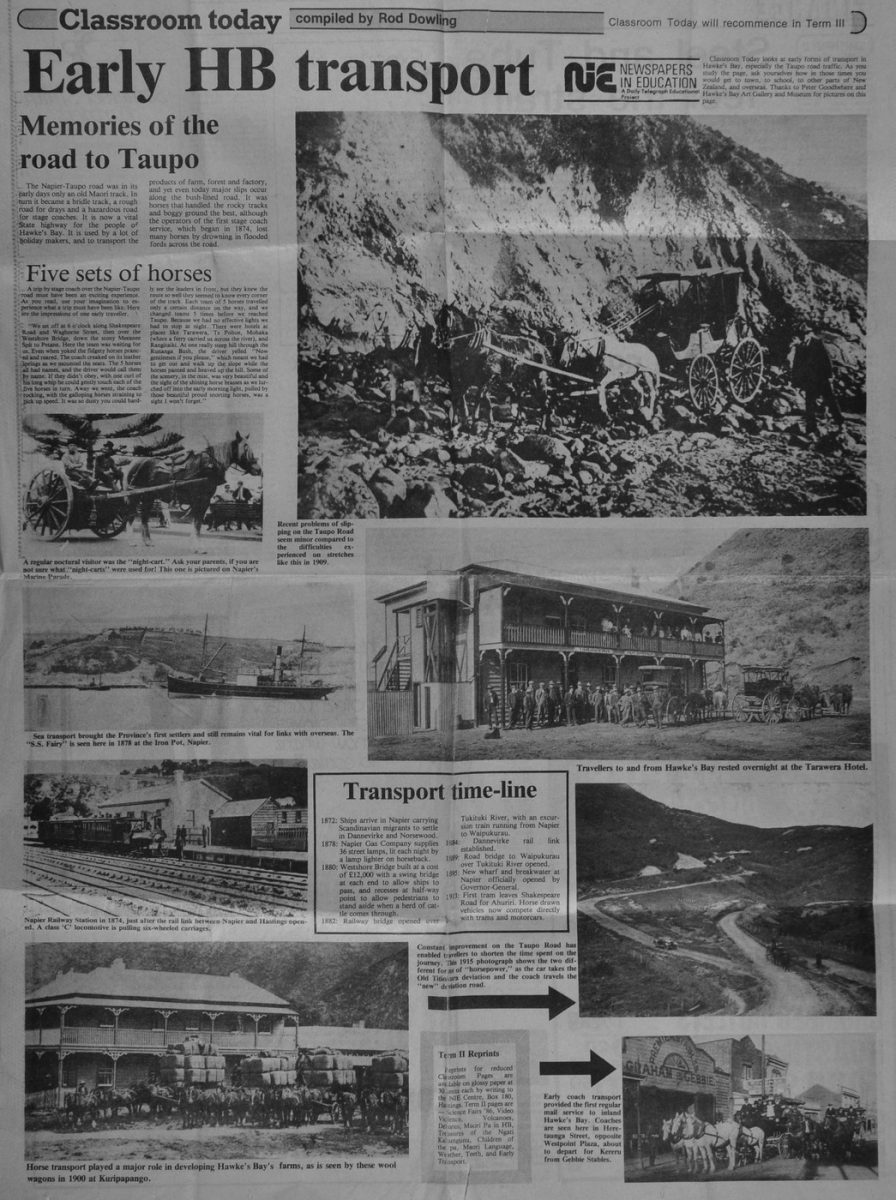Classroom today compiled by Rod Dowling Classroom Today will recommence in Term III
Early HB transport
NIE NEWSPAPERS IN EDUCATION
A Daily Telegraph Educational Project.
Classroom Today looks at early forms of transport in Hawke’s Bay, especially the Taupo road traffic. As you study the page, ask yourselves how in those times you would get to town, to school, to other parts of New Zealand, and overseas. Thanks to Peter Goodbehere and Hawke’s Bay Art Gallery and Museum for pictures on this page.
Memories of the road to Taupo
The Napier-Taupo road was in its early days only an old Maori track. In turn it became a bridle track, a rough road for drays and a hazardous road for stage coaches. It is now a vital State highway for the people of Hawke’s Bay. It is used by a lot of holiday makers, and to transport the products of farm, forest and factory, and yet even today major slips occur along the bush-lined road. It was horses that handled the rocky tracks and boggy ground the best, although the operators of the first stage coach service, which began in 1874, lost many horses by drowning in flooded fords across the road.
Five sets of horses.
A trip by stage coach over the Napier-Taupo road must have been an exciting experience. As you read, use your imagination to experience what a trip must have been like. Here are the impressions of one early traveller.
“We set off at 6 o’clock along Shakespeare Road and Waghorne Street, then over the Westshore Bridge, down the stony Meeanee Spit to Petane. Here the team was waiting for us. Even when yoked the fidgety horses pranced and reared. The coach creaked on its leather springs as we mounted the seats. The 5 horses all had names, and the driver would call them by name. If they didn’t obey, with one curl of his long whip he could gently touch each of the five horses in turn. Away we went, the coach rocking, with the galloping horses straining to pick up speed. It was so dusty you could hardly see the leaders in front, but they knew the route so well they seemed to know every corner of the track. Each team of 5 horses travelled only a certain distance on the way, and we changed teams 5 times before we reached Taupo. Because we had no effective lights we had to stop at night. There were hotels at places like Tarawera, Te Pohue, Mohaka (where a ferry carried us across the river), and Rangitaiki. At one really steep hill through the Runanga Bush, the driver yelled “Now gentlemen if you please,” which meant we had to get out and walk up the slope while the horses panted and heaved up the hill. Some of the scenery, in the mist, was very beautiful and the sight of the shining horse brasses as we lurched off into the early morning light, pulled by those beautiful proud snorting horses, was a sight I won’t forget.”
Transport time-line
1872: Ships arrive in Napier carrying Scandinavian migrants to settle in Dannevirke and Norsewood.
1878: Napier Gas Company supplies 36 street lamps, lit each night by a lamp lighter on horseback.
1880: Westshore Bridge built at a cost of £12,000 with a swing bridge at each end to allow ships to pass, and recesses at half-way point to allow pedestrians to stand aside when a herd of cattle comes through.
1882: Railway bridge opened over Tukituki River, with an excursion train running from Napier to Waipukurau.
1884: Dannevirke rail link established.
1889: Road bridge to Waipukurau over Tukituki River opened.
1895: New wharf and breakwater at Napier officially opened by Governor-General.
1913: First tram leaves Shakespeare Road for Ahuriri. Horse drawn vehicles now compete directly with trams and motorcars.
Photo captions –
A regular nocturnal visitor was the “night-cart”. Ask your parents, if you are not sure what “night-carts” were used for! This one is pictured on Napier’s Marine Parade.
Recent problems of slipping on the Taupo Road seem minor compared to the difficulties experienced on stretches like this in 1909.
Sea transport brought the Province’s first settlers and still remains vital for links with overseas. The “S.S. Fairy” is seen here in 1878 at the Iron Pot, Napier.
Travellers to and from Hawke’s Bay rested overnight at the Tarawera Hotel.
Napier Railway Station in 1874, just after the rail link between Napier and Hastings opened. A class ‘C’ locomotive is pulling six-wheeled carriages.
Constant improvement on the Taupo Road has enabled travellers to shorten the time spent on the journey. This 1915 photograph shows the two different forms of “horsepower”, as the car takes the Old Titiokura deviation and the coach travels the “new” deviation road.
Horse transport played a major role in developing Hawke’s Bay’s farms, as is seen by these wool wagons in 1900 at Kuripapango.
Early coach transport provided the first regular mail service to inland Hawke’s Bay. Coaches are seen here in Heretaunga Street, opposite Westpoint Plaza, about to depart for Kereru from Gebbie Stables.
Term II Reprints
Reprints for reduced Classroom Pages are available on glossy paper at 30 cents each by writing to the NIE Centre, Box 180, Hastings. Term II pages are – Science Fairs ’86, Video Violence, Volcanoes, Debates, Maori Pa in HB, Treasures of the Ngati Kahungunu, Children of the pa, Maori Language, Weather, Teeth, and Early Transport.












Do you know something about this record?
Please note we cannot verify the accuracy of any information posted by the community.